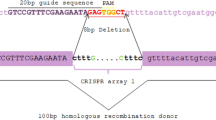Abstract
Two δ-integration vectors were evaluated for the insertion of an inducible expression cassette (the yeast CUP1 promoter fused to the Escherichia coli lacZ structural gene, CUP1p-lacZ) and a bacterial neomycin-resistance gene (neo) into the genome of Saccharomyces cerevisiae via homologous recombination. Cells containing integrations were selected by resistance to the aminoglycoside G418. The first vector was a traditional construct containing only one δ sequence; with this vector, the transformation efficiency and the number of integrations per cell were quite low. The second carried two δ sequences flanking the desired insert, and the unneeded bacterial sequences were removed by restriction-enzyme digestion immediately before transformation. When this double δ vector was employed, the integrated copy number was more than doubled relative to the single δ system and final β-galactosidase levels exceeded those obtained with the 2μ-based plasmid. Furthermore, the integrations appeared more stable in long-term sequential culture (both with and without induction of the lacZ gene) than those obtained via the single δ vector.
Similar content being viewed by others
Author information
Authors and Affiliations
Additional information
Received: 2 December 1996 / Received revision: 21 March 1997 / Accepted: 13 April 1997
Rights and permissions
About this article
Cite this article
Lee, F., Silva, N. Improved efficiency and stability of multiple cloned gene insertions at the δ sequences of Saccharomyces cerevisiae . Appl Microbiol Biotechnol 48, 339–345 (1997). https://doi.org/10.1007/s002530051059
Issue Date:
DOI: https://doi.org/10.1007/s002530051059



